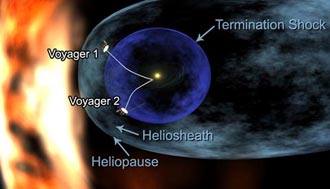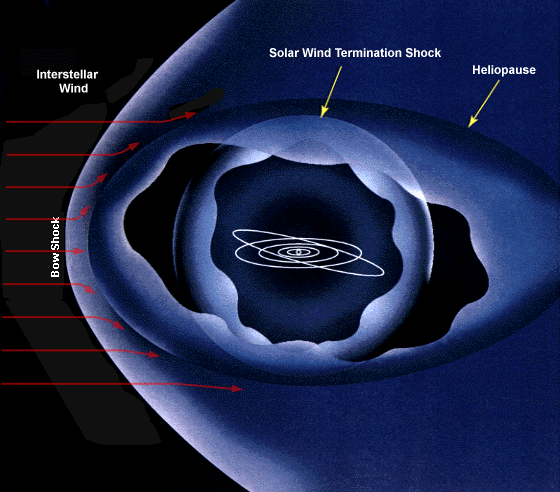Using information obtained from NASA's Voyager 2 spacecraft reveals that the bubble around a system formed by the solar wind is not round but slightly squashed due to magnetic effects

The solar wind is a stream of charged particles emitted from the sun's upper atmosphere, those particles move at a speed of 300 to 800 km per second and they manage to escape from the sun's gravity mainly because of their high temperature and other reasons that we still do not understand.
While the sun's gravity pulls objects like the Earth in, the solar wind has the opposite effect and pushes objects out. This is one of the reasons why we are protected from the interstellar weather. The solar system is exposed to the forces of space, but the solar wind blows away most of the particles and protects the objects that are in the heliosphere - the atmosphere of the solar system. The place where the solar wind stops protecting us is called the "heliopause", this theoretical limit has never been explored (until now).

Although they failed to measure it, the scientists believed that the "bubble" created by the solar wind is round. However, new information revealed by NASA's old spacecraft tells a different story.
In a series of articles published this week in Nature magazine, the researchers reveal that the solar wind is exposed to external magnetic influences, therefore its shape is not round but more "squished". The ion flux and the galaxy's magnetism do not penetrate the bubble region in full force, but the process affects the shape of the bubble.
A pair of Voyager spacecraft were sent in 1977 to the outer solar system to study Jupiter, Saturn, Uranus and Neptune. At the end of the research mission, it was decided to launch them to the edges of the solar system to explore new areas, and despite all the technical problems, the scientists managed to collect significant information from the distant regions of the solar system. Voyager 2 is at the boundary between the bubble and interstellar space so that the effect of interstellar space forces on the bubble can be better measured by analyzing cosmic rays that come from outer space.

18 תגובות
Pine:
Another Asimov story that might be even more appropriate is:
http://www.briandgoad.com/Jokester.doc
Pine:
Indeed heaven is an appropriate expression.
I wonder if this is an initiative of the kindergarten itself or if it comes from the children.
The fact that it was presented as an unanswered question suggests that this is probably a discussion that the children initiated and the teacher had no answer.
In any case - the questions are often more important than the answers.
Most people spend their lives without asking themselves anything - not even about the things they see every day.
It reminds me of several stories by Asimov, one of which - if I remember correctly (because it must have been 40 years since I read it) is the story "Professional" that appears in the collection "Tomorrow Double 9"
I don't understand why they expected to round?
After all, there is no such thing as round in the universe where the curvature of space applies to everything.
So were we supposed to take into account the rotation of the sun around the galaxy and the radiation of the galaxy or not? Or they took it into account and it turned out that there should be less than there really is. And then start thinking about dark matter as another factor?
hook,
Michael - Did you find the lost "Paradise" huh? 🙂
Yes, I wish they had taught me all this in kindergarten.
Actually... I wish they would try to teach us this and in general give some connection to science back in school.
The sun has an almost spherical shape (almost round), with about 9 millionths of stars. That is:
That is, the polar diameter (which passes between the poles) is about 10 km less than the transverse diameter (the equatorial / "equator" line).
The average circumference is about 1,392,000 km, so you will be able to understand how insignificant the difference is.
While the diameter of the Earth is on average 12,742 km. When the radius at the poles is 6356 km, and at the equator 6378 km. That is, the difference in diameter is 44 km, which is more distinct relative to the size of the Earth.
Kian:
Another thing I wanted to tell you is that your garden is probably a wonderful garden.
Kian:
Almost, but not quite.
Because of its rotation around an axis, the radius of the sun at the equator is slightly larger than the radius at the pole.
Of course, there are also the temporary phenomena of eruptions that change the shape of the sun in a certain area for a short time, but I guess that's not what you meant in the question.
I would like to know the answer to the question - a topic we are talking about now in my kindergarten - is the sun round? My mom and I read together about the solar system, and we couldn't find the answer. I would be very grateful if you could answer my question. Kian
Hello astrophysics experts,
I have a question that has been bothering my desire to understand for a long time, and perhaps, this is the place and the time
For a question in public, for the purpose of verification and examination of the matter.
I was told from a primary and authorized source in his own way, which I am unable to reveal at this time,
that the age of the sun's consciousness is 6 billion years. To be more precise, another 18 must be added to the function.. Is there any figure, in the scientific-astrophysical calculations
Or the astronomers, who can shed light on the matter? Or if there is any link
indicating any insinuation in the matter.?
Thank you, from the bottom of my heart..to anyone who has even a pinch..an idea..I will try to check a way as well
More links, to be invited to me.
a question:-
If, as written in the article, the magnetic radiation comes from the galaxy to the sun, it should arrive in a very special way. As we know, the plane of motion of the planets in our solar system is inclined about 60 degrees to the plane of the galaxy, therefore radiation that will reach us from the galaxy will hit the sun at an angle of 60 degrees relative to the plane of the solar system, meaning that there will be a deflection here according to the axis of the galaxy. Is it at the level of what is happening? I didn't see a mention of that in the article.
In addition, the movement of the sun around the galaxy must also be taken into account.
good evening
Sabdarmish Yehuda
A question to Rami when the Atlantis shuttle will be launched to Hubble
FIXED, THANK YOU.
Regarding NASA, below is a press release on a close and related topic:
http://www.nasa.gov/home/hqnews/2008/jul/HQ_08165_STEREO.html
Our solar system is hiding in a bubble……..
To my dear father!
Why is there no reference to the source in NASA??
Sabdarmish Yehuda
"But the solar wind exceeds most of the particles", apparently it should be - "repelled".
Good Day
Sabdarmish Yehuda
So what, we still live in a bubble.
And this bubble will burst!
We live in a bubble